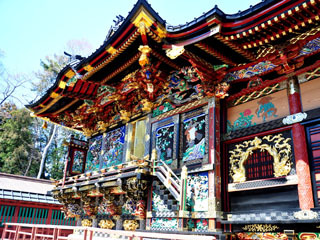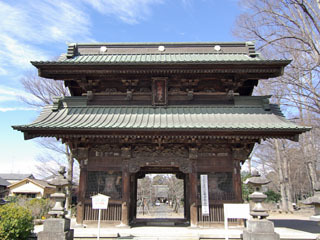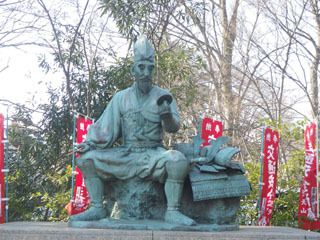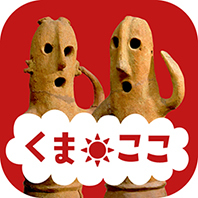令和3年度「地域観光資源の多言語解説整備支援事業」ー妻沼聖天山歓喜院 全体概要ー [その他]
Menuma Shodenzan Temple Overview
妻沼聖天山歓喜院全体概要

The grounds of Menuma Shodenzan Temple include a lavishly decorated main hall, and a stroll garden with Buddhist statuary and a pagoda. The main hall, the Shodendo, exemplifies the decorative temple architecture of the mid-Edo period (1603–1867), and is often compared to Nikko Toshogu Shrine in Tochigi Prefecture for its elaborate carvings. The main hall was built in 1760 and venerates Shoden (or Kangiten), the deity of joy, conjugal harmony, and longevity. Menuma Shodenzan Temple was founded in 1179 by Saito Sanemori (1111–1183), a legendary samurai and military commander.

The gateway to the temple
The Kisomon Gate is the main entrance to the temple. It has an unusual roof with three overlapping gables, which protect the elaborate decorations carved on the eaves and lintels beneath from the elements. The detailed, three-dimensional carvings include two guardian Nitenno figures (Heavenly Kings) flanking the Kisomon Gate.
The main approach leads to the Shodendo, the main hall and the spiritual heart of the temple. The exterior of the Shodendo is adorned with colorful carvings depicting allegories, Buddhist teachings, and images from classical Chinese culture. The Shodendo is designated a National Treasure.

A valiant warrior
A statue of temple founder Saito Sanemori (1111–1183) depicts him in his seventies holding a mirror and an ink brush, poised to color his gray hair black. He was determined not to be underestimated by younger warriors and is said to have dyed his hair black before fighting in the Battle of Shinohara (1183), where he met his demise. Sanemori was the governor of present-day northern Saitama and served as a retainer to the powerful Heike family, who fought for control of Japan in the twelfth century.

A garden of peace and harmony
The stroll garden behind the main temple buildings has a winding path that takes visitors past a stream and waterfall, as well as Buddhist statuary. The two-story Heiwa no To Peace Pagoda in the garden commemorates the people who lost their lives in World War II and was built to mark the ratification of the San Francisco Peace Treaty of 1951. Two trees known as the Meoto no Ki (wedded trees) grow close together with their roots entwined and are believed to symbolize a strong and happy relationship.
Menuma Shodenzan Temple is in the center of Menuma, an area in the north of Kumagaya, in Saitama Prefecture. Many of the temple structures were built with donations from the local community.
※この英語解説文は観光庁の地域観光資源の多言語解説整備支援事業で作成しました。

The grounds of Menuma Shodenzan Temple include a lavishly decorated main hall, and a stroll garden with Buddhist statuary and a pagoda. The main hall, the Shodendo, exemplifies the decorative temple architecture of the mid-Edo period (1603–1867), and is often compared to Nikko Toshogu Shrine in Tochigi Prefecture for its elaborate carvings. The main hall was built in 1760 and venerates Shoden (or Kangiten), the deity of joy, conjugal harmony, and longevity. Menuma Shodenzan Temple was founded in 1179 by Saito Sanemori (1111–1183), a legendary samurai and military commander.

The gateway to the temple
The Kisomon Gate is the main entrance to the temple. It has an unusual roof with three overlapping gables, which protect the elaborate decorations carved on the eaves and lintels beneath from the elements. The detailed, three-dimensional carvings include two guardian Nitenno figures (Heavenly Kings) flanking the Kisomon Gate.
The main approach leads to the Shodendo, the main hall and the spiritual heart of the temple. The exterior of the Shodendo is adorned with colorful carvings depicting allegories, Buddhist teachings, and images from classical Chinese culture. The Shodendo is designated a National Treasure.

A valiant warrior
A statue of temple founder Saito Sanemori (1111–1183) depicts him in his seventies holding a mirror and an ink brush, poised to color his gray hair black. He was determined not to be underestimated by younger warriors and is said to have dyed his hair black before fighting in the Battle of Shinohara (1183), where he met his demise. Sanemori was the governor of present-day northern Saitama and served as a retainer to the powerful Heike family, who fought for control of Japan in the twelfth century.

A garden of peace and harmony
The stroll garden behind the main temple buildings has a winding path that takes visitors past a stream and waterfall, as well as Buddhist statuary. The two-story Heiwa no To Peace Pagoda in the garden commemorates the people who lost their lives in World War II and was built to mark the ratification of the San Francisco Peace Treaty of 1951. Two trees known as the Meoto no Ki (wedded trees) grow close together with their roots entwined and are believed to symbolize a strong and happy relationship.
Menuma Shodenzan Temple is in the center of Menuma, an area in the north of Kumagaya, in Saitama Prefecture. Many of the temple structures were built with donations from the local community.
※この英語解説文は観光庁の地域観光資源の多言語解説整備支援事業で作成しました。






